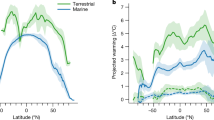Abstract
Acclimation is possibly the most important criterion deciding an animal’s ability to survive change. Species with poor abilities to acclimate to small environmental change are likely to be the most vulnerable in future warming scenarios. Two separate assemblages of Ophionotus victoriae were slowly acclimated from 0°C to either +2 or +3°C and then held at these higher temperatures over a prolonged timescale. None of the animals were able to acclimate; with failure occurring from day 19 at +3°C and day 24 at +2°C, indicating that this species is very sensitive to small long-term seawater temperature increases. These data indicate that O. victoriae has probably the poorest ability to acclimate to elevated temperatures of any species studied to date. Given previous data showing some Antarctic fish can acclimate to +4°C, the predicted effects of increased seawater temperatures on the Antarctic food web and ecology must be assessed at the individual species level and interpreted with care.

Similar content being viewed by others
References
Arnaud PM, Lópoz CM, Olaso I, Ramil F, Ramora-Esplá AA, Ramos A (1998) Semi quantitative study of the macrobenthic fauna in the region of the South Shetland Islands and the Antarctic Peninsula. Polar biol 19:160–166
Arntz WE, Brey T, Gallardo VA (1994) Antarctic zoobenthos. Oceanogr Mar Biol 32:241–304
Bailey DM, Johnston IA, Peck LS (2005) Invertebrate muscle performance at high latitudes: swimming in the Antarctic scallop Adamussium colbecki. Polar Biol 28:464–469
Barnes DKA, Griffiths HJ (2008) Biodiversity and biogeography of southern temperate and polar bryozoans. Global Ecol Biogeogr 17:84–99
Barnes DKA, Fuentes V, Clarke A, Schloss IR, Wallace M (2006) Spatial and temporal variation in shallow seawater temperatures around Antarctica. Deep Sea Res II 53:853–865
Fratt DB, Dearborn JH (1984) Feeding Biology of the Antarctic brittle star Ophionotus victoriae (Echinodermata: Ophiuroidea). Polar Biol 3:127–139
Gonzalez-Cabrera JJ, Dowd F, Pedibhotla VK, Rosario R, Stanley-Samuelason D, Petzel D (1995) Enhanced hypo-osmoregulation induced by warm acclimation in Antarctic fish is mediated by increased gill and kidney Na+/K+-ATPase activities. J Exp Biol 198:2279–2291
Jin Y, DeVries AL (2006) Antifreeze glycoprotein levels in Antarctic notothenioid fishes inhabiting different thermal environments and the effect of warm acclimation. Comp Biochem Physiol B 144:290–300
Lowe CJ, Davison W (2005) Plasma osmolarity, glucose concentration and erythrocyte responses of two Antarctic nototheniid fishes to acute and chronic thermal change. J Fish Biol 67:752–766
Madsen FJ (1967) Ophiuroidea. British and Australian NZ Antarctic Research Expedition 1929–1931. Rep Adelaide (Ser B Zool Bot) 9:123–145
Meredith MP, King JC (2005) Rapid climate change in the ocean west of the Antarctic Peninsula during the second half of the 20th century. Geophys Letts 32:L19604–L19609
Murphy JM, Mitchell JFB (1995) Transient response of the Hadley Centre coupled ocean-atmosphere model to increasing carbon dioxide. J Climate 8:36–514
Peck LS (1989) Temperature and basal metabolism in two Antarctic marine herbivores. J Expt Mar Biol Ecol 127:1–12
Peck LS (2002) Ecophysiology of Antarctic marine ectotherms: limits to life. Polar Biol 25:31–40
Peck LS (2005) Prospects for survival in the Southern Ocean: vulnerability of benthic species to temperature change. Antarctic Sci 17:497–507
Peck LS, Conway LZ (2000) The myth of metabolic cold adaptation: oxygen consumption in stenothermal Antarctic bivalve molluscs. In: Harper E, Crame AJ (eds) Evolutionary biology of the bivalvia. Geological Society of London Special publication 177. Cambridge University Press, Cambridge, pp 441–450
Peck LS, Pörtner HO, Hardewig I (2002) Metabolic demand, oxygen supply and critical temperatures in the Antarctic bivalve Laternula elliptica. Physiol Biochem Zool 75:123–133
Peck LS, Webb KE, Bailey DM (2004) Extreme sensitivity of biological function to temperature in Antarctic marine species. Funct Ecol 18:625–630
Peck LS, Webb KE, Miller A, Clark MS, Hill T (2008a) Temperature limits to activity, feeding and metabolism in the Antarctic starfish Odontaster validus. MEPS 358:181–189
Peck LS, Clark MS, Morley SA, Massey A, Rosetti H (2008b) Animal temperature limits: effects of size, activity and rates of change. Funct Ecol (in press)
Podrabsky JE, Somero GN (2006) Inducible heat tolerance in Antarctic nothothenioid fishes. Polar Biol 30:39–43
Pörtner HO (2002) Physiological basis of temperature-dependent biogeography: trade-offs in muscle design and performance in polar ectotherms. J Exp Biol 205:2217–2230
Sáiz-Salinas JL, Ramos A, Garcia FJ, Troncoso JS, San Martin G, Sánz C, Palacin C (1997) Quantitative analysis of macrobenthic soft bottom assemblages in South Shetland waters (Antarctica). Polar Biol 17:393–400
Seebacher F, Davison W, Lowe CJ, Franklin CE (2005) A falsification of the thermal specialisation paradigm: compensation for elevated temperatures in Antarctic fishes. Biol Lett 1:151–154
Somero GN, DeVries AL (1967) Temperature tolerance of some Antarctic fishes. Science 156:257–258
Stillman JH (2003) Acclimation capacity underlies climate change susceptibility. Science 301:65
Waller C, Barnes DKA, Convey P (2006) Ecological contrasts across an Antarctic land-sea interface. Aust Ecol 31:656–666
Zachos JC, Wara MW, Bohaty S, Delaney ML, Petrizzo MR, Brill A, Bralower TJ, Premoli-Silva I (2003) A transient rise in tropical sea surface temperature during the Paleocene-Eocene thermal maximum. Science 302:1551–1554
Acknowledgments
This paper was produced within the BAS Q4 BIOREACH/BIOFLAME core programmes. The authors would like to thank all members of the Rothera Dive Team for providing samples. Overall diving support was provided by the NERC National Facility for Scientific Diving at Oban.
Author information
Authors and Affiliations
Corresponding author
Rights and permissions
About this article
Cite this article
Peck, L.S., Massey, A., Thorne, M.A.S. et al. Lack of acclimation in Ophionotus victoriae: brittle stars are not fish. Polar Biol 32, 399–402 (2009). https://doi.org/10.1007/s00300-008-0532-y
Received:
Revised:
Accepted:
Published:
Issue Date:
DOI: https://doi.org/10.1007/s00300-008-0532-y




